
(Download a higher
resolution image by clicking on any picture below.) 
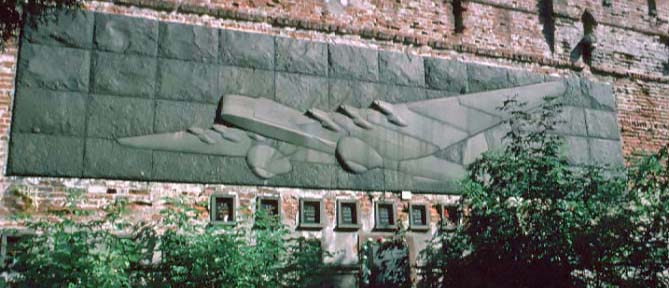 Monument to the victims of the Maxim
Gorky disaster. Tupolev's ANT-20 Maxim Gorky was
the largest airplane in the world in the mid-1930s. It made its
first flight on June 17, 1934. It had a wingspan of 206 feet 98
inches and it was 107 feet 11 inches long. It had a wing area of
5,231 square feet and a gross weight of 92,600 pounds.
Monument to the victims of the Maxim
Gorky disaster. Tupolev's ANT-20 Maxim Gorky was
the largest airplane in the world in the mid-1930s. It made its
first flight on June 17, 1934. It had a wingspan of 206 feet 98
inches and it was 107 feet 11 inches long. It had a wing area of
5,231 square feet and a gross weight of 92,600 pounds.
The Maxim Gorky was a major Soviet propaganda tool. It appeared regularly in overflights of Moscow. Patriotic music was broadcast from loudspeakers, leaflets were dispensed, and parachutists jumped from the Maxim Gorky. Shortly after flying over a parade at red square on May 18, 1935, it was struck by a fighter plane trying to fly a loop around it. It crashed into a residential neighborhood in Moscow, killing 41 people. No larger airplane flew until the very similar Tupolev Ant-20bis was built in 1939.
Link to Tupolev company page about their airplanes, including the ANT-20 Maxim Gorky.
 Monument to the victims of the
Airship V6 crash. General Umberto Nobile of Italy spent five
years in Russia after the Italia disaster on the polar ice cap.
During that time, the Soviets built nine semi-rigid airships of
his design, including the V6.
Monument to the victims of the
Airship V6 crash. General Umberto Nobile of Italy spent five
years in Russia after the Italia disaster on the polar ice cap.
During that time, the Soviets built nine semi-rigid airships of
his design, including the V6.
The V6 Osoaviakhim was 104.5 meters long. Its envelope held 18,500 cubic meters of hydrogen lifting gas. It cruised at about 95 kilometers per hour. It was based in Moscow. In 1936 it made training flights to Leningrad, Archangel, Kazan, Kar'kov and Kiev. In 1937 it flew from Moscow to Sverdlovsk and made an endurance flight of 4,800 kilometers in 130½ hours.
An airship station was constructed at Novosibirsk to support Trans-Siberian Airship Service. Before the V6 could make its first flight to the new station, it was ordered to assist in the evacuation of the Soviet North Pole scientific research station. A disintegrating ice floe threatened to sink the station. The V6 departed from Dolgoprudeyi hanger on 5 February 1938 to join other aircraft, icebreakers and submarines.. The airship crashed into Mount Neblo on the Kola Peninsula the following day. Thirteen of the nineteen on board were killed. They are interred in cubicles below the relief of the airship.
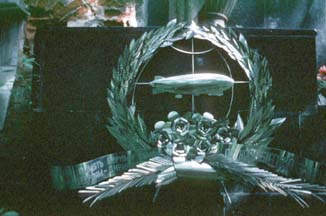 Detail of the monument to the
victims of the Airship V6 crash, February 6, 1938.
Detail of the monument to the
victims of the Airship V6 crash, February 6, 1938.
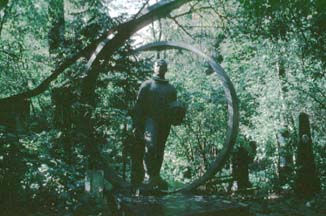 Monument to cosmonaut Pavel I. Belyayev. Born 1925 - Died 1970.
He was a crew member on Voskhod 2. He remained aboard the
spacecraft while Lt. Colonel Aleksey Leonov made the first
spacewalk in March 1965.
Monument to cosmonaut Pavel I. Belyayev. Born 1925 - Died 1970.
He was a crew member on Voskhod 2. He remained aboard the
spacecraft while Lt. Colonel Aleksey Leonov made the first
spacewalk in March 1965.
Link to Astronautix.com page about Pavel I. Belyayev.
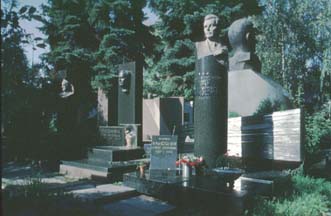 Monument to aircraft designer Sergey
Vladimirovich Ilyushiin. Born Mar. 30, 1894 - Died Feb. 9, 1977
Monument to aircraft designer Sergey
Vladimirovich Ilyushiin. Born Mar. 30, 1894 - Died Feb. 9, 1977
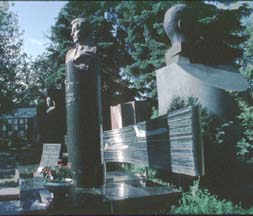 Monument to aircraft designer Sergey
Vladimirovich Ilyushiin.
Monument to aircraft designer Sergey
Vladimirovich Ilyushiin.
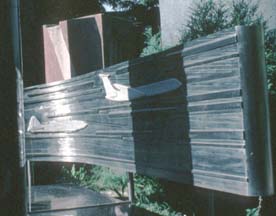 Monument to aircraft designer Sergey
Vladimirovich Ilyushiin.
Monument to aircraft designer Sergey
Vladimirovich Ilyushiin.
 Monument to aircraft designer Semyon Lavochkin.
Born September 11, 1900 - Died June 9, 1960.
Monument to aircraft designer Semyon Lavochkin.
Born September 11, 1900 - Died June 9, 1960.
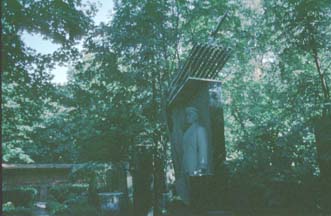 Monument to a commander of the Rocket Corps.
Monument to a commander of the Rocket Corps.
 Nikita
Krushchev, Born April 17, 1894 - Died September 11, 1971 was not
sufficiently favored to make it to Red Square. He is interred at
the Novodevichy Cemetary.
Nikita
Krushchev, Born April 17, 1894 - Died September 11, 1971 was not
sufficiently favored to make it to Red Square. He is interred at
the Novodevichy Cemetary.
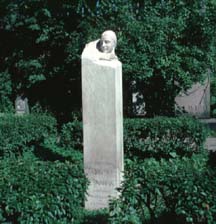 Stalin's wife Allilueva is also at Novodevichy. Born 1901 - Died
November 9, 1932.
Stalin's wife Allilueva is also at Novodevichy. Born 1901 - Died
November 9, 1932.
Novodevichy Cemetary Links:
Send a message to Brian. 